HOW TO BUY A SEIKO 7002 DIVER
Page 1 of 1
 HOW TO BUY A SEIKO 7002 DIVER
HOW TO BUY A SEIKO 7002 DIVER
This is a great post from Gabe (Isthmus) made at wus. I contacted him last week and he said we could repost this here.
I've been looking into Seikos trying to figure out the models, movements and the interchangeability of the parts and found his posts to be very informative.
Thanks Gabe!
http://forums.watchuseek.com/showthread.php?t=258086
The following is a guide made from my own observations, together with research of many many posts made on SCWF and WUS regarding these watches over the past many years, and excellent direct feedback provided by several forum members. To all who have looked into these watches in the past, and to those who so graciously donated your time and effort to help make this guide a reality, you have my most sincere thanks. Most particularly special thanks to Richard Ng for his tireless editing and his generous image donations, as well as Mark Adeney, Lew Brown and Jack Alexyon, who at one time or another have all served as a second set of eyes and a never ending fountain of knowledge and advice. Also big thanks to Shawn Stanford, who's diver heaven articles were a wonderful resource and guide to follow in creating this guide. The pictures included have been donated by different members. However I also flagrantly "borrowed" some pictures that were posted to the forum and the divers reference (I hope you don't mind my using them here). There are so many pictures that I'm unable to keep track of them all, so if you see your picture being used and would like me to remove it or add your name as the source, please e-mail me and let me know. Also, if you have anything in the article should be quoted or attributed to you, also please let me know so I can make sure that it is. Once again, thanks to all those who donate of your time to review this guide and who donated images specifically for this project. Thanks all of you for your inputs.
Please note that the guide focuses solely on 7002 ISO rated dive watches and does not address other Seikos (including sport divers) that used the 7000 series of movements. Also please note that this is not a technical guide, but rather a general guide for enthusiasts and collectors to help them identify the different models of 7002 divers, their general history and condition.
I suspect there is information that has been left out so, please feel free to add any information and images you feel are worth adding. If anything you see in here is in need of expansion or correction, please let me know and I will gladly update it with any information you can provide.
I will only be making on-going updates to the copy of this guide saved on this Archive. If you ever need to find the most up to date version of this guide (as with the rest of the buying guides I've written) the one saved there will be the most current one.
THIS GUIDE MAY NOT BE REPRODUCED OR REPOSTED ANYWHERE ELSE WITHOUT MY EXPRESS PERMISSION. You are welcome to link to it where it is hosted on SCWF or Watchuseek.
I hope you enjoy the guide.
Gabe
------------------------------------------------------------------------------------------
HOW TO BUY A SEIKO 7002 DIVE WATCH

HISTORY:
The Seiko 7002 series of diving watches is the fourth generation of Seikos (normally aspired) professional/recreational ISO-rated automatic diving watches (this does not include Seikos deep diving shrouded divers or Seikos intro level ISO-rated quartz divers). The 7002 line of divers replaced the 6309 in 1988 and ran until 1996. It was replaced by the SKX line of divers in 1996. The 7002s use an entirely different movement from prior 6000 series based models used in earlier divers. The 7002s (especially the second generation) introduced many design changes to Seiko divers that are with us to this day.
The 7002 divers came in two generations spanning eight models. Both generations shared the same slimed-down case similar to the one introduced by the second generation 6309 divers, and a form of which is still in use to this day.
This guide will first focus on those things which all 7002 ISO rated divers share in common. The guide will then outline the eight separate models and the differences among them.
GENERAL CHARACTERISTICS:
7002 ISO rated dive watches are easily identifiable for having only a date wheel (no day). With the exception of the 7002-7020/9, they all use rectangular hour markers, which are covered in a greenish lume (possibly promethium) that predated Seikos use of lumibrite. This lume is notorious for aging poorly and for losing its luminous qualities after a few years, while still looking good cosmetically. This lume is also notorious for being copied by aftermarket parts sellers and being recreated to have lume with a neon-like green hue, which originals never had. The following is a description of the watchs specific characteristics:
CASE:
All 7002 divers come in a slimmed down stainless steel case similar to the one introduced by the second generation of 6309 divers. The case measures approximately 41mm in width (47mm including the crown); 45mm in length (lug to lug); 13mm in thickness; and 22mm in lug width. These cases also incorporate a small blister shaped guard which protects the crown and is somewhat reminiscent of the much larger guard found on vintage 6105 divers. It is important to note that since 7002 divers came in two generations there are two different but very similar cases used depending on which generation you have.
Overall, the case has a combination of polished surfaces (on the sides & bottom of the case and top of the crown guard) and machined/satin surfaces (on the top of the case and the lugs) and is composed of a combination of softly curved surfaces. The main creases on the case are found on either side of the case, where the bottom of the case curves upward and meets the downward slope of the upper part of the case. The creases along the sides of the case should be well defined (though not razor sharp), while those in the lower crown guard are slightly less sharp. Both tend to get rounded-off (the recess creases can sometimes disappear entirely) when cases are improperly refinished. Like the 6309-729A case that preceded it, the 7002 case does not have a beveled recess at either side of the crown. Instead, the inner parts of the crown guards are sharp vertical cuts that parallel the sides of the crown. The easiest way to tell the difference between a 7002 case and a slimmed down 6309 case is to look at the crown guards from the rear. You will notice that, because of the different crown designs, the 6309 case has an additional recess cut out into the base of the crown guards in order to fit the telescopic crown. The 7002 crown guards have a solid base with no cut-out.
The biggest differences between the two generations of 7002 cases are in the bezel mechanisms and in the crystals. If you remove the rotating ring, you will notice that the first generation 7002 is a solid surface underneath the bezel. The click mechanism is a spring loaded ball similar (but not exactly the same) to the one used in the 6309 divers series. In the second generation 7002 divers, when the bezel is removed, you will find a circular recess on the periphery of the crystal, inside you will find a circular click-spring, very much like those used on modern Seiko divers. Another difference is that the two generations use different sized crystals. First generation 7002s use a 32mm diameter crystal, while the second generation models use a 31mm diameter crystal.
These watches have integrated, threaded crown tubes which are intended to accommodate a traditional screw-down type crown and tube (previous 6309 Seiko divers used a thick telescopic type of crown system). It is important to note that damaged crown tubes cannot be replaced. Depending on the type and extent of the damage, a bad crown tube can destroy an otherwise great looking case.
Since so many of these watches were sold in and/or used in humid environments, it is very important to examine both the inside and outside of the case for signs of rust and, in particular, rust related pitting. Mild surface rust can be cleaned; pitting can be a sign of much more extensive damage and can ruin a case. Pay particular attention to corrosion to the inside of the case, under the gasket sealing areas of the case, to the flat surface where the gasket sits on the case-back, and to the threads where the case-back and crown screw in. Corrosion in these areas is common on these watches. A little bit of pitting on the threads can be halted, but too much can prevent the case-back from closing properly or can allow water to enter the watch when placed under increased water pressure. With new seals a case with slight rust damage to gasket sealing areas can be dust sealed, but probably not be made water-resistant. IF YOU WANT A WATER RESISTANT CASE GET ONE WITH NO RUST. Since the majority of you are desk divers, price is often an issue, and this is a vintage diver, you might be OK with a little bit of thread damage so long as the watch can be dust sealed - just avoid getting them wet, no matter how nice they look.
Lastly, deformation (and to a lesser degree rust) can also be an issue with regard to lug-pin holes. This part tends to have a greater potential for deformation and rust damage than most others. In order to correct deformation damage, unscrupulous repairmen tend to just drill the holes to a bigger size. The problem with this is that eventually the lug-pin holes get so large and worn out that it would be insane to expect a spring bar to stay in them. This is not fixable, and means the case is junk (unless you want to drill all the way through and manufacture your own screw type springbars I didnt think so). Try to use fat Seiko springbars whenever possible, as small ones will not fill in the lug pin holes fully and can scrape around the inside, deforming the hole.
CROWN:
Crown is a thick, horizontally toothed (for ease of finger-grip) unsigned crown, of a traditional spring loaded design mounted directly on the crown-stem as one piece (unlike the telescopic 6309 design). The crown should screw down a minimum of 1.5 complete turns (more is preferable). Any less than 1.5 turns and the threads are most likely damaged, and you would be wise to avoid this case. However, quite often crown turning problems tend to be caused by damaged crown threads (those on the inner/underside of the crown) and not the threads on the cases crown-tube. If you have a problem, you are advised to check before throwing out that case since the crown IS easily replaceable. It is important to note that the crown on the 7002 uses smaller gaskets than that of the preceding 6309, which makes the gaskets lifespan shorter. If you want to maintain water resistance, keep this in mind and have your gaskets changed accordingly.
BEZEL:
All first generation 7002 divers have mildly angled (the outer edge is marginally higher than the edge closest to the crystal) 60-click, bi-directional, non-locking bezels, with black-painted aluminum bezel inserts, silver markings and a large recessed round lume dot/pip.
Second generation 7002s (except 7002-7020 & 7029) have much flatter (the outer edge is closer in height to the edge closest to the crystal) 120-click, uni-directional (counterclockwise), locking bezels, with black-painted aluminum bezel inserts, silver markings and a small recessed round lume dot/pip.
The bezel in the 7002-7020 & 7029 is a 120-click, uni-directional (counterclockwise), locking bezel, with an all-metal starfish shape (with recessed numbers instead of an insert) reminiscent of similar designs from Tag-Heuer, and a medium recessed round lume dot/pip.
Bezel mechanisms on first generation cases use a spring-loaded click ball recessed into the top of the case at 1:30, and a bezel with 60 detent notches on its underside (similar in design to the system used in the 6309 divers):
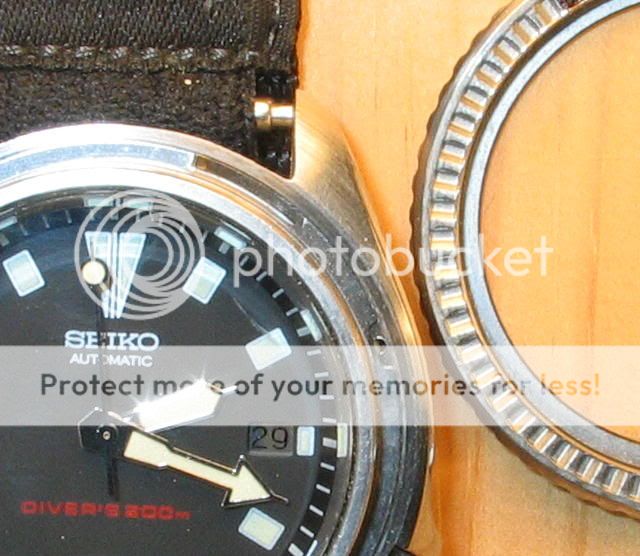
[img]https://img.photobucket.com/albums/v373/Santeno/DIVERS/7002%20Gide%20Pictures/Bezel%20Mechanism/BezelMechanismMkI.jpg]/img]
Bezel mechanisms on second generation cases use a flat circular spring lying between the bezel and the case (similar to the system used in current SKX divers). The spring is prevented from rotating by two downward-facing tabs which engage two holes in top of the case. The spring engages the detent grooves of the bezel by two upward-facing tabs which engage the detent notches in the underside of the bezel. Interestingly, there are only 60 detent notches in the underside of the bezel, but a 120 click rotation is achieved by locating the upward-facing spring tabs so that one snaps in a notch as the other, located 177 degrees away, is midway between two notches:
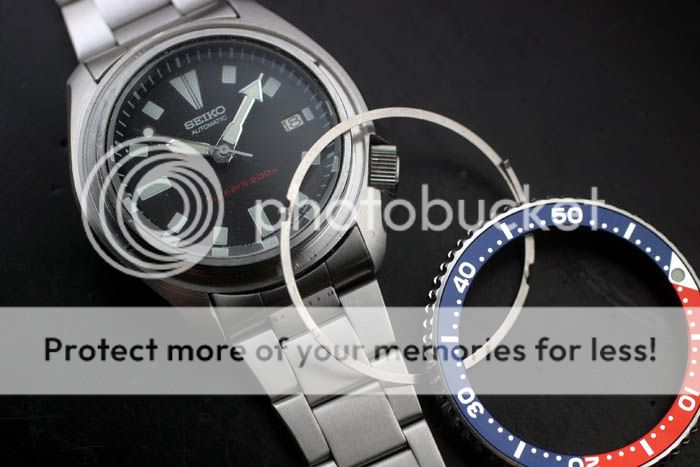
The bezel inserts on 7002 divers vary slightly depending on the generation. First generation 7002 divers use the exact same bezel insert used in 6309 divers, right down to the oversized lume pip. Unlike 6309s, the first generation 7002s also had a Pepsi style variant of the same insert. Second generation versions used the insert used in the modern SKX divers, which is not angled and has a smaller lume dot. Bezel inserts in 7002s are removable and replaceable, so dont let a nice watch with a damaged insert keep you from getting a good deal. Keep in mind that both the bezel and the insert for each generation of 7002s, are different (inserts are interchangeable though). For instructions on how to change and remove a 7002 bezel and a bezel insert, check out this link (not about 7002s but the process is essentially the same):
http://www.network54.com/Forum/78440...6gt%3B%26gt%3B
The bezel ring itself is bordered by two stacked rows of rectangular cut protrusions that aid with finger-grip during bezel turning. If you look closely at the bottom of the bezel (where it meets the case), you will notice that ORIGINAL bezels are not flat, but rather have a series of tiny incisions/dimples which should be centered with the centerline that separates each rectangular finger grip aftermarket bezels sometimes lack these. If you buy a 7002 with a non-turning bezel, dont be disheartened; again, this should be a relatively simple fix and should not be a deal breaker.
It is worth noting that many owners have reported being able to swap entire bezel assemblies between 7002-7039s and 7Sxx/SKX divers as well as between the 7002-7020/9 and the SKX171. However these transplants are not always successful, with some reporting that the swapped parts sometimes fit too tight or too lose in the recipient watch. I have looked into the matter personally and found that although similar, second generation bezel assemblies are different and are not meant to be swapped with SKX divers, as they have ever so slightly different dimensions. First generation bezel assemblies are not swappable with any latter Seiko divers.
CRYSTAL:
The crystal should be a non-AR-coated Seiko Hardlex mineral crystal. It's supposed to be flat, have a frosted beveled edge, and should only protrude a minute amount beyond the top of the inner edge of the bezel but never beyond the outer edge of the bezel. Examples offered on eBay often have after-market crystals which noticeably project (stick out) above the bezel or use a domed acrylic crystal with curved edges. Proper aftermarket and Hardlex replacements do exist and can be sourced. After market sapphire crystals are popular and desirable modification for folks who intend to wear their watches on a daily basis (sapphire is great at scratch resistance), so dont dismiss a domed crystal as undesirable always ask the seller what type of crystal you are looking at. Be warned, however that most watchmakers will be unable to test the watch t its original stated depth rating after the crystal has been swapped.
The crystals on 7002 ISO divers are NOT held in place by a crystal retaining ring (as with the 6309). Instead they use a setup similar to what is used with todays SKX divers, where the crystal is pressed directly into a nylon crystal gasket avoiding the corrosion problems experienced by 6309 retaining rings.
CASE-BACK:
The case-back is a variation of Seikos standard 6-slot screw-type case-back. It is made of stainless steel and has a raised relief stamping of the full sized Seiko tsunami wave in the center. Deeply stamped (looking almost engraved) in a clockwise circular layout around the image of the tsunami wave can be found one of the following variants of the words:
1. JAPAN A (Daini lightning bolt logo) STAINLESS STEEL SEIKO (the word Seiko is written in larger font) 7002-70_ _ (with the being the case number for the corresponding model) A1 (inside a box) SCUBA DIVERS:
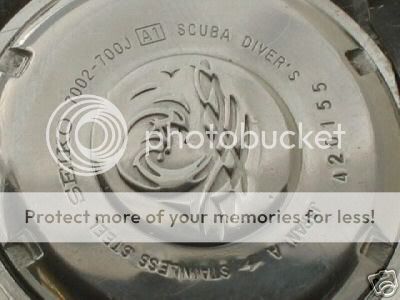
2. A (Daini lightning bolt logo) STAINLESS STEEL SEIKO (the word Seiko is written in larger font) 7002-70_ _ (with the being the case number for the corresponding model) A1 (inside a box) SCUBA DIVERS:
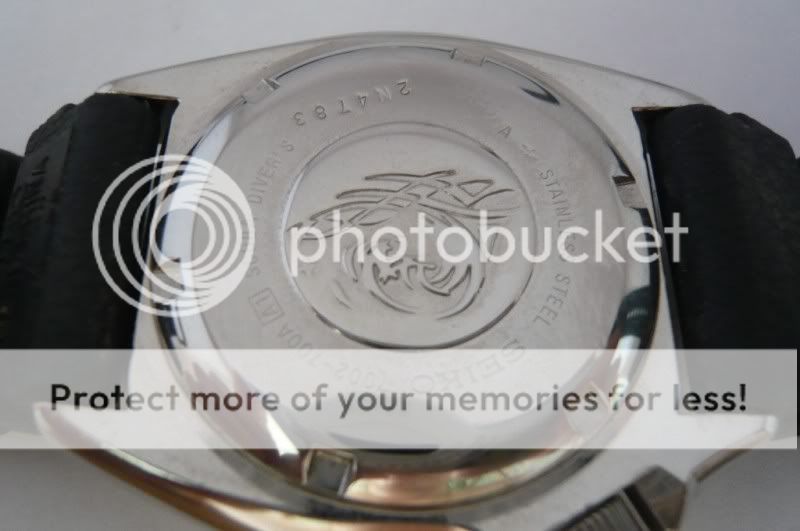
3. A (Daini lightning bolt logo) STAINLESS STEEL SEIKO (the word Seiko is written in larger font) 7002-70_ _ (with the being the case number for the corresponding model) A0 (inside a box) SCUBA DIVERS; or
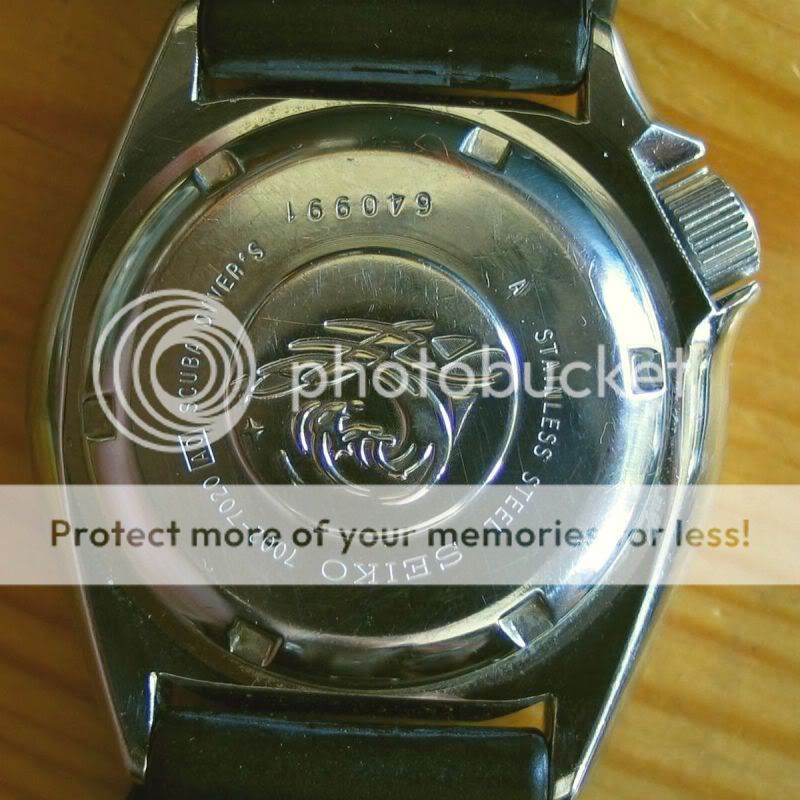
4. A (Daini lightning bolt logo) STAINLESS STEEL SEIKO (the word Seiko is written in larger font) 7002-70_ _ (with the being the case number for the corresponding model) A0 (inside a box) SCUBA DIVERS. On this variant the text MOVT SINGAPORE can be found written left to right below the tsunami logo directly above the serial number.

I believe that the first two caseback codes (marked A1) belong to first generation cases and the second two (marked A0) belong to second generation cases. However Im not positive about this so feel free to verify this and correct me. If anyone notices other variants of the caseback information, please let e know and Ill include it in an update to this guide.
Below the image of the wave, deeply stamped (looking almost engraved) in a standard, straight (non-arched), left to right horizontal layout is the watchs specific, six-digit serial number.
Often times when case-backs are refinished, the stamped information gets sanded to the point of looking worn or faded. It is supposed to be sharply stamped, and it is never laser etched.
DIAL:
With the exception the 7002-7020 and 7002-7029, the faces of all 7002 divers are characterized by rectangular hour markers at 1, 2, 3, 4, 5, 6, 7, 8, 9, 10 & 11. The rectangular-shaped hour markers at 6 & 9 are about twice the length of those at 2, 4, 5, 7, 8, 10 & 11. The rectangular marker at 3 sits outboard of the date window and is a little less than half the size of those at 2, 4, 5, 7, 8, 10 & 11. The hour marker at 12 is composed of two identical downward pointing right scalene triangles, set mirroring each other and with the right angle at the top inner corner. There is a line of silver paint that separates each of the triangles.
With the exception of the 7002-7020 & 7002-7029, the date wheels on 7002 ISO divers are silver in color and have Arabic numerals written in black ink. 7002-7020 & 7002-7029 ISO divers use black date wheels with Arabic numerals written in white ink.
All hour markers are lumed. However, it must be noted that the lume is relatively flat and does not occupy the entire hour marker (it is framed by the markers silver border). Original factory lume, as seen in the picture below, has an almost textile looking quality to it, almost like it is linen, with slight cross hatching visible when viewed with a strong loupe (this is from the printing process Seiko used). It is important to note that the lume used in 7002s was different than that used in preceding 6309s, as well as that used in subsequent SKX divers.
7002 lume has a greenish silvery color to it when seen under visible light and glows with a noticeable bright greenish hue. When new, 7002 lume tended to be rather bright green, however, as it aged, it tended to quickly turn grey when exposed to environmental moisture. Sadly 7002 lume was not of the same quality as the lumibrite in use today. The greenish lume had a tendency to lose a considerable amount of its luminosity after a few years. During the 1980s Seiko switched to a radioactive compound made of Promethium-147 as the basis for the lume used in 7002 divers. The luminous properties turned out to have a pretty short life span and didn't last nearly as long as the old tritium-based lume Seiko used in the 1970's. This is why a lot of the 7002 divers seem to have lume problems even though they are a relatively new watch, and today are "outshined" by original lume on 6309 divers which are nearly twice their age. Most 7002s found today, when they have clean dials, tend to have lume with little to no luminosity left. It is worth noting that some collectors believe that Seiko might have experimented with different lume applications or types of lume during the production life of the 7002 line. I have not been able to find definitive proof of this, but I believe that there might be at least two different forums of lume used by Seiko on this model. Also, the 7020 variant definitely uses a different form of lume that is completely white.
Here is a link with lots of interesting technical information on Promethium-147:
http://www.hps.org/publicinformation/ate/q3408.html
and here is a slightly less technical post explaining the differences between Promethium, Lumibrite and Tritium, as used by Seiko (read to the end):
http://www.larrybiggs.net/scwf/index...&id=1085718911
All 7002 first generation ISO-rated Divers have the words SEIKO AUTOMATIC written in whitish silver paint one above the other, directly below the 12:00 marker and the words WATER150mRESIST just above the 6:00 marker. More specific dial details will be addressed when we talk about the specific 7002 models.
It is worth noting that, in original condition, the words WATER and RESIST were painted in an orangey shade of red, while the 150m was painted whitish silver paint. However, over the years the red color tends to fade, turning anywhere from orange to yellow to grey over time (so dont stress too much about finding them in perfect red condition). Having this text in white is a dead giveaway of an aftermarket dial. The only white on the 7002 dial should be the dial code:
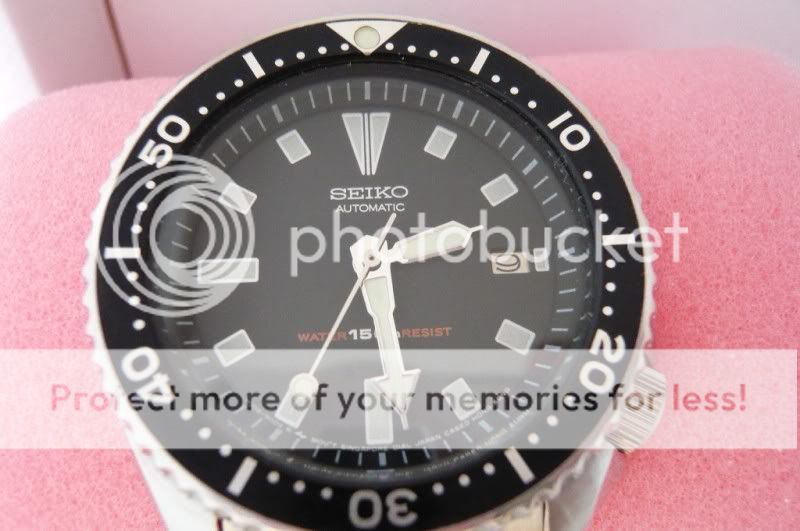
Below the 6:00 marker, stretching as far as between the 7:30 & 4:30 is written in tiny white letters the dial code. These dial codes tell us what movement the dial belongs to, what dial version this is, and sometimes where the dial was made, where the case was made and what market the watch was originally destined for, be it Japan, the Americas, or everybody else.
It is important to note that, unlike with 6309s, it is considerably more difficult to tell a reproduction dial from a real one by analyzing the dial code. The easiest way to determine the authenticity of a 7002 dial is by paying close attention to the color of the lume (which should never have a bright green or neon-like hue to them, and which should always be framed in their markers in silver paint, not white). Because of the sheer variety of dials and dial codes (and inconsistency in lume degradation) it is not as easy to tell a fake 7002 dial from an original, as it is with 6309's. A good rule of thumb is that the lume in 7002's does not age well and tended to darken rather quickly from its bright green original condition. It is very uncomon to find these bright green lumed dials. Many of the current reproductions have this bright green lume on watches that have obviously seen better days. Text size on dial codes is also a way to tell a reproduction from an original.
In the case of second generation 7002 divers, the description above applies to the dials of 7002-7039s with the exception that, instead of saying WATER150mRESIST, the watchs rating upgrade cased the text to be changed to DIVERS 200m, written in red (a slightly darker shade than the orangey red used in the first generation):
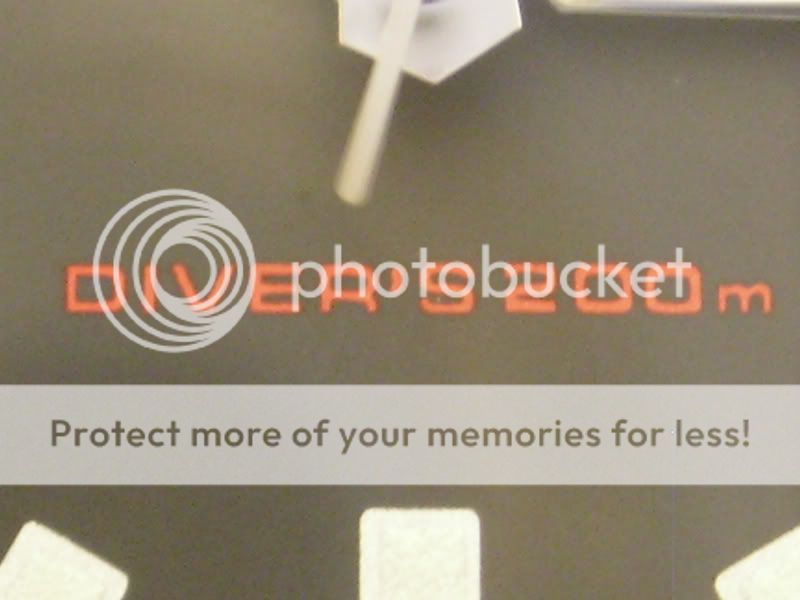
7002-7020s and 7002-7029s have drastically different dials. Unlike all other 7002s and 6309s which had printed dials, these models had polished silver, applied hour markers. The faces of all 7002-7020 and 7002-7029 divers are characterized by circular applied hour markers at 1, 2, 4, 5, 7, 8, 10 & 11. The hour markers at 6 & 9 are pentagon shaped with a projecting tip and resemble the silhouette of a house. They are very similar to the general shape of the hour hand but with parallel sides instead of tapered ones. There is no hour marker at 3, but the date window is framed by a silver painted box with rounded corners just outboard of the actual date window cut-out. The hour marker at 12 is similar to the shape of the markers at 6 and 9, but is about twice as wide and with the proportions reversed (the outer section is shorter while the inner section is longer and has a longer tip). Like the hands, the hour marker lume filled the entire space within the polished frame of the marker. Unlike prior 7002s, the lume used in these models was not green but rather white. Like the 7039, the 7002-7020 and 7002-7029 divers also replace the WATER150mRESIST rating text from the first generation 7002s to DIVERS 200m. Unlike the 7039, the 7002-7020 and 7002-7029 divers had DIVERS 200m written in the same whitish silver paint used in the words SEIKO AUTOMATIC, instead of red.:
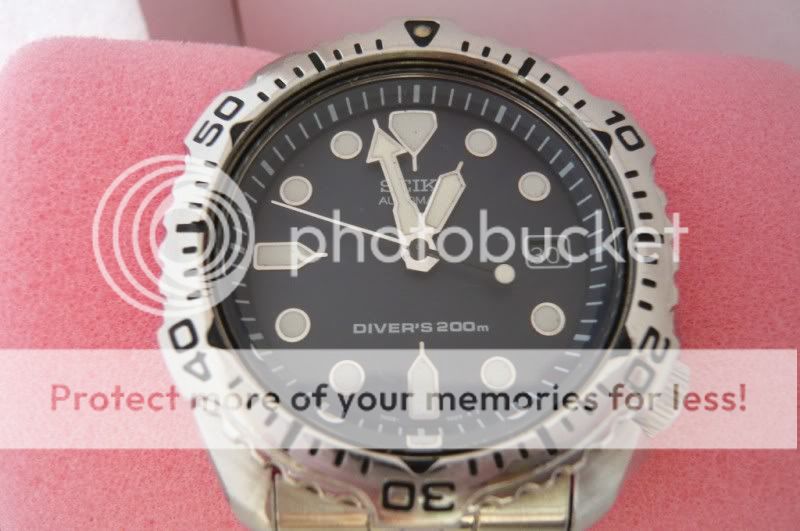
All 7002s used the same black chapter ring with 60 white minute markers. The minute markers where slightly thicker at every 5 minute mark than at the minute markers in between.
HANDS:
Unlike flat 6309 hands, original 7002 hour hands are flat-topped and have rounded edges and finished in a high polish. Replacement hands from Seiko will be identical to those used in modern SKX divers. All the watchs hands are polished metallic hands and are silver in color. The hour and minute hands have a large lume insert in the middle that follows the shape of the hand. Unlike the hour markers, the lume on the hands fills the entire space of the insert. With the exception of the 7002-7020 & 7002-7029, the second hands are very similar to those used in the prior 6309s, except that they have slightly rounded outer edges. 7002 second hands only have a lume dot near their outer end, which like the lume used on the hour markers is not puffy.
7002-7020s & 7002-7029s used the same hour hands as earlier 7002s, but the second hand reversed the position of the flying meatball lume dot from just below the leading end of the second hand to the trailing end and extended the trailing end a few extra millimeters so that it resembles a tail. In addition the second hands on 7002-7020s & 7002-7029s are painted in a glossy black paint from the central axle hub to the lumed meatball the forward, un-lumed, pointy end is left unpainted, in what Seiko calls a Day/Night configuration.
MOVEMENT:
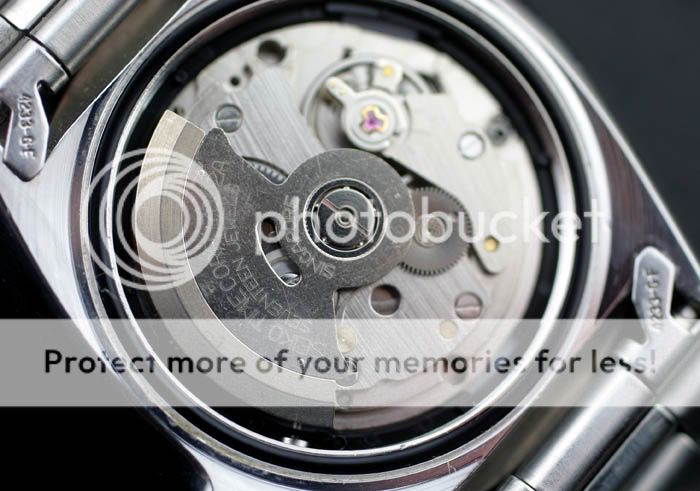
7002s use a form of Seikos workhorse 17 jewel 7000 series automatic caliber. The movement cannot be manually wound, is non-hacking and has crown operated quickset day/date calendar mechanisms. The movement is loosely based on seikos 7000 series of movements from the early 70s, such as the 7005. Unlike its ancestors or the 6309 that preceded it, the 7002 has fewer parts, uses stamped metal parts instead of machined metal parts (modern 7s movements are also stamped), uses plastic parts much more extensively than prior Seiko movements, and has a slightly shorter power reserve than the 6309 (still 40+ and in keeping with the similar power reserve of the 7s movements that followed). Many on the boards have commented that the reason for these design and construction changes where largely due to Seiko looking to create a less expensive movement, because of the pressures of the quartz revolution placed on the mechanical movement market.
7002s also use a plastic movement spacer ring, whereas the 6309 used a metal ring with a compression spring on it. Over time, the plastic Spacer ring can become susceptible to temperature fluctuations and contract or deform, causing a not-quite perfect fit, which has been known to allow minor dial movement when adjusting the time (this is correctible by simply replacing the old spacer with a new one).
It is important to note that as a result of cost savings sought in the design and construction of the 7002 movement, while 7002 movements remain robust and solid movements, overall they just dont tend to age as well as their older 6309 counterparts. In part this is reflected in current resale values for 7002s (very good examples of which can still be had for under $100), which do not approach those of the similar 6309-7290 (let alone the 7040/9). Again, none of this means that the 7002 is a bad movement. It only means that compared to its predecessors, more emphasis was place in cost control than in overall movement construction and longevity. The 7002 series of movements are good movements, but when compared to their predecessors (and their successors) perhaps not great.
For the common buyer, so long as the movement works and keeps good time, make sure that the movement looks clean with no black, pitted or rusted parts, and make sure that you have an un-cracked plastic movement spacer ring.
As an aside, the modern 7S series of movements are direct evolutions of the 7002 movement. Seiko did correct some of their less desirable design approaches in the 7002 in the design of the subsequent 7s26, while still retaining their focus on robustness and economy. In the 7Sxx series of movements Seiko made the power reserve a little longer by increasing the number of cap jewels (7s26= 21J vs. 7002=17J). They also made changes to the balance assembly resulting in better accuracy. The 7002, along with corrections and modifications, evolved into the 7Sxx series of movements we know today (and the 6rxx series is a further evolution of that). However, in many ways neither of these later movements truly compare to the 6309 in terms of finish or construction. If you want to learn more about their differences between the 7000 series and the 6309, read the last 2 posts on this thread:
http://www.larrybiggs.net/scwf/index...1&id=997293604
In addition here is a wonderful and rather technical site outlining the general differences between the 7000 series of movements and the 6000 series of movements:
http://adenoma.sites.uol.com.br/61xx-70xx-english.html
If you want to learn more about the differences and similarities between the 7000 series and the 7s movements that followed, please read these 2 posts by Adriano:
http://www.network54.com/Forum/78440...o+they+differ-
http://www.network54.com/Forum/78440...hat%2C+in+fact
STRAP:
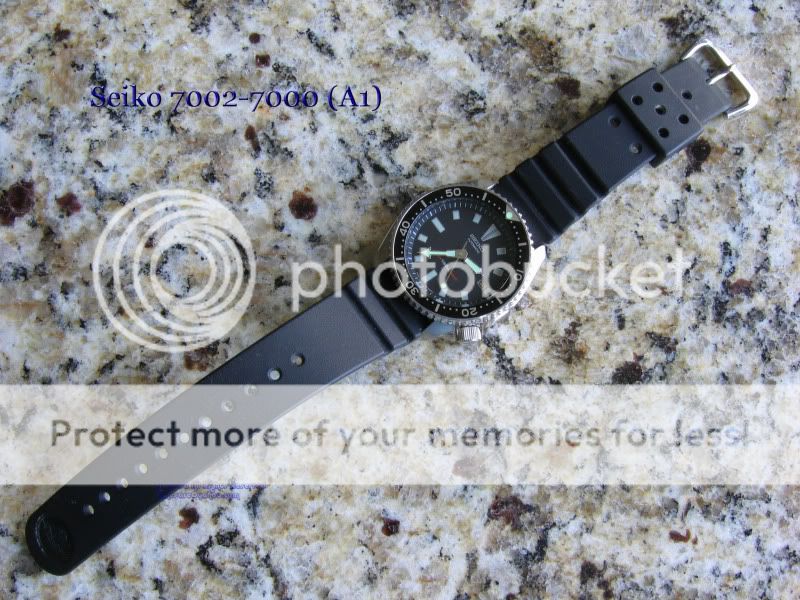
First generation 7002s were only offered with black, straight vented GL-831 rubber straps. The long strap has two vents separated by flat ridges and 11 adjustment holes followed by an image of the Seiko tsunami wave inside a recessed circle near the rounded tip. The short strap has 3 vents separated by flat ridges, 3 offset rows of non-usable perforations and an unattached rectangular strap-guard with 5 similar perforations. The end is followed by a smallish (for the watch) traditional buckle set-up with the words SEIKO.ST.STEEL.JAPAN.Z on the underside.
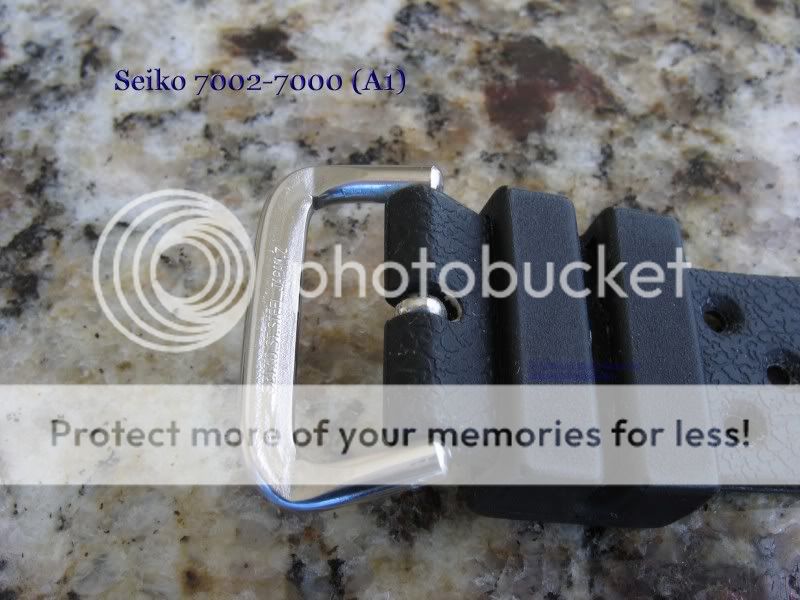
Some people strive for originality and must have an original strap. The original strap should be marked "SEIKO GL-831 JAPAN". Seiko made them of a silicone rubber compound. Today, the market is flooded with replacement rubber straps from all kinds of sources. I would not suggest stressing over the correct rubber strap and would advice that you find a good after market replacement.
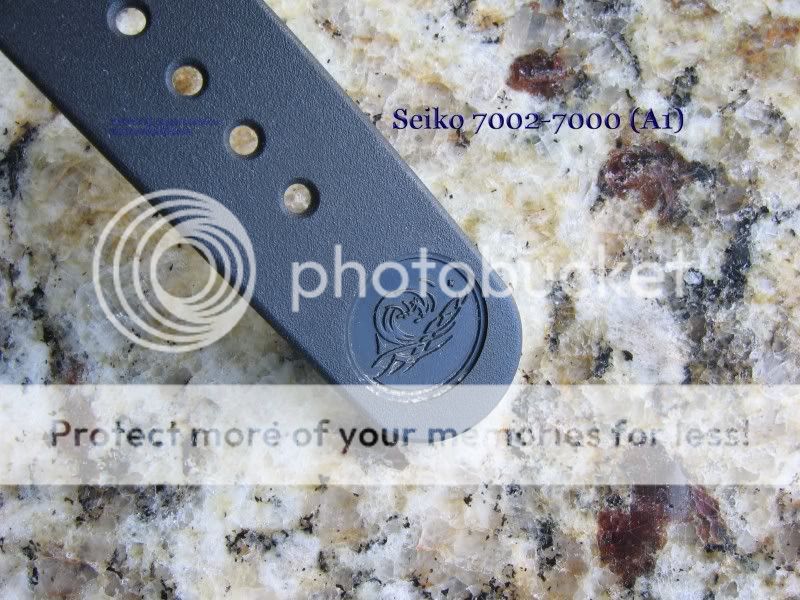
Second generation 7002 divers also used GL-831 rubber straps, however they also introduced the use of metal oyster style (and jubilee) bracelets. I have not been able to confirm whether the jubilees used in the 7002 had solid outer links or folded ones. If any of you have an original and could confirm, Ill include the information in an update to this guide.
Its worth noting that Seiko divers use FAT spring-bars. These are not regular 22mm spring-bars, but rather heavy duty 22mm spring-bars made especially for Seiko divers.
SPECIFIC MODEL DIFFERENCES:
The 7002 divers came in two generations, both in a slimmed down case similar to the one introduced by the second generation 6309 divers and in a form of which is still in use to this day. Unlike the 6309 that preceded it and the SKX that followed it, there are no orange or yellow dialed 7002 ISO-rated divers!!! It is worth noting that as with the 6309's that preceeded it there was some overlap in the production run between the first and second generations. At least in some markets, where seiko produced watches locally, such as brazil (see update below), the first generation continued in production right to the end of the entire model line's (firs and second generation) production run.
The eight different models and two generations of the 7002 diver are as follows:
FIRST GENERATION
7002-7000: This is the international version (non-Japan / non-U.S.) of the normally aspired 150m-rated 7002 (1st generation) diver. Except for the caseback marketing code, it is identical to the 7002-7009 diver (0 instead of 9). It is ISO rated to 150m. The dial code on these normally reads either as: 7002-700X R ~ MOV'T SINGAPORE DIAL JAPAN CASED HONG KONG; or can also read as: 7002 (Daini lightning bolt logo) 700R R

7002-7009: This is the U.S. version of the normally aspired 150m-rated 7002 (1st generation) diver. Except for the caseback marketing code, it is identical to the 7002-7009 diver (9 instead of 0). These 2 are both 150m divers. It is ISO rated to 150m. The dial code on these normally reads: 7002-700X R (Daini lightning bolt logo) MOV'T SINGAPORE DIAL JAPAN CASED HONG KONG.

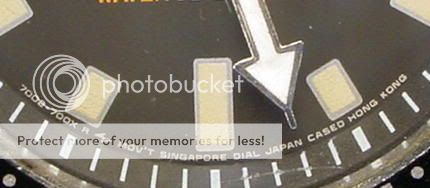
7002-7001: This is the Japanese home market version of the normally aspired 150m-rated 7002 (1st generation) diver. It is supposed to be cased in Japan and have a Japan made movement. It differs from the more popular 7000 and 7009 in that the jewel-count (17 Jewels) is written on the dial directly below the depth rating (WATER150mRESIST). The dial code on these normally reads: MADE IN JAPAN 7002-700L R , followed by the Daini lightning bolt logo.
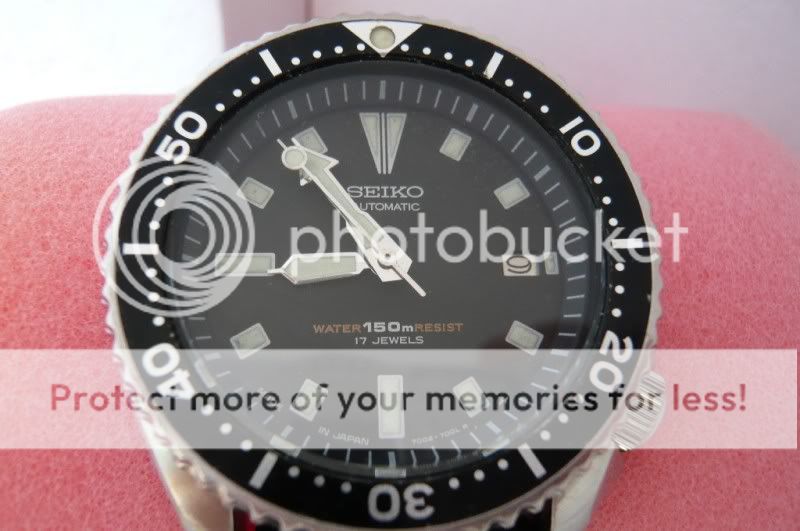
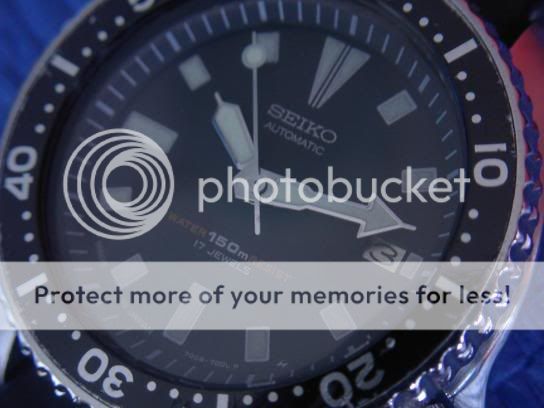
7002-700A: This is the international version (non-Japan / non-U.S.) of the normally aspired 150m-rated 7002 (1st generation) Pepsi diver. It is largely identical to the watches above except that it has a blue-and-red Pepsi-style bezel. The dial code on these normally reads: 7002 (Daini lightning bolt logo) 700R R.
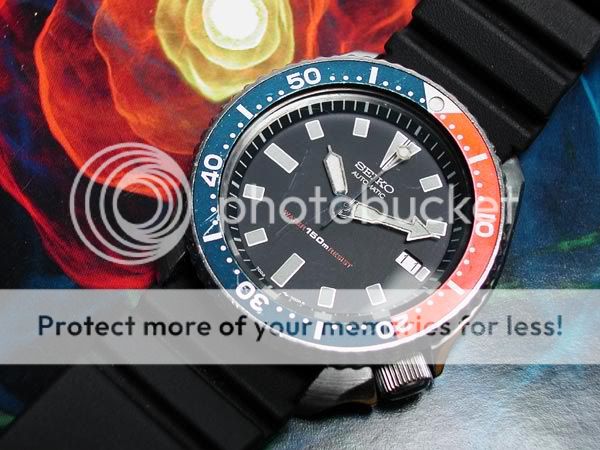

7002-700J: This is the Japanese home market version of the normally aspired 150m-rated 7002 (1st generation) Pepsi diver (according to Shawn Taylor). Like the 7002-7001 it differs from the more popular 7000A in that the jewel-count (17 Jewels) is written on the dial directly below the depth rating (WATER150mRESIST). Like the 700A, it also has a blue-and-red Pepsi-style bezel. As with the 7002-7001, the dial code on these normally reads: MADE IN JAPAN 7002-700L R , followed by the Daini lightning bolt logo.
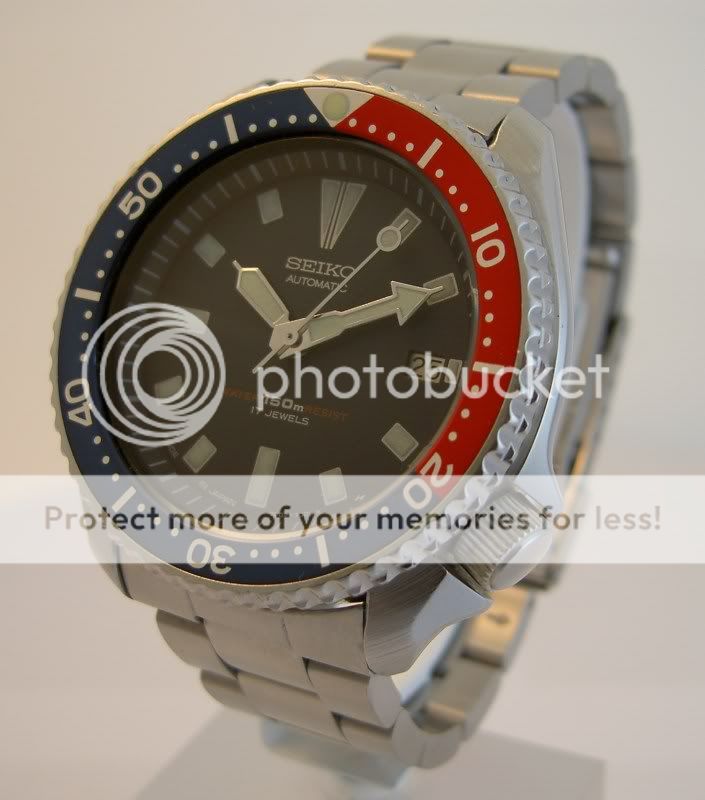
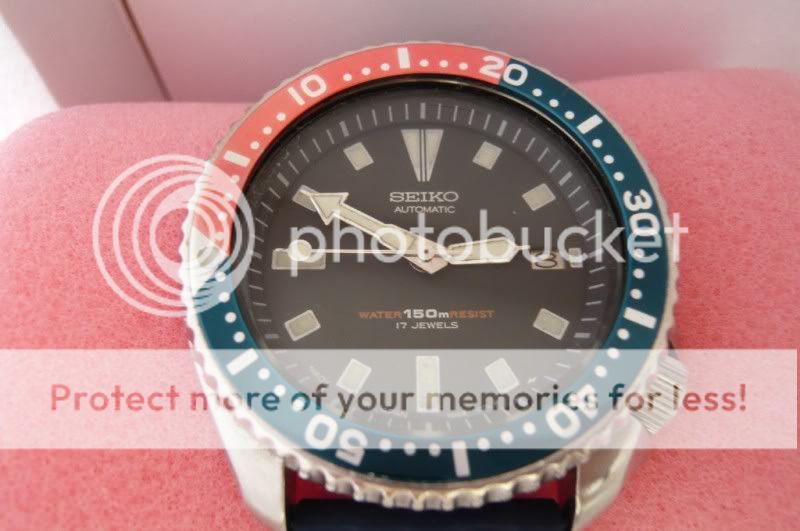

SECOND GENERATION
7002-7039: This is the international version (all markets) of the normally aspired 200m-rated 7002 (2nd generation) diver. This model is the first normally aspired ISO rated Seiko diver to have its water resistance rating upgraded to 200m. It is believed that Seiko increased the depth ratings on their base divers in response to revised ISO standards. The watch came available with both black and Pepsi-style bezels (aside from the bezel insert color, they were otherwise identical). While the first generation (150m) 7002 divers had 60-click bi-directional bezels, second generation (200m) 7002 divers came with a uni-directional (counterclockwise turning) 120-click locking bezel. It is worth noting that not only is the bezel assembly different from that of earlier 7002s, but the insert is also a different part number from that of earlier 7002s (which were shared with the 6309 divers that preceded them). These divers also mark the first time the depth rating dial text changed from WATER150Mresist to DIVER'S 200m, as used in modern SKX divers. The dial code on these normally reads either as: 7002-703X R 2 CASED HONG KONG; or as 7002-703X R 2 MOV'T SINGAPORE CASED HONG KONG.
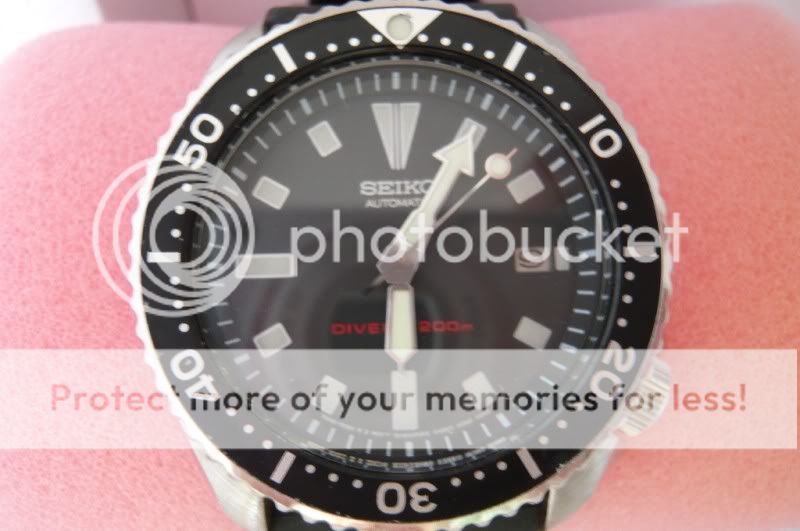
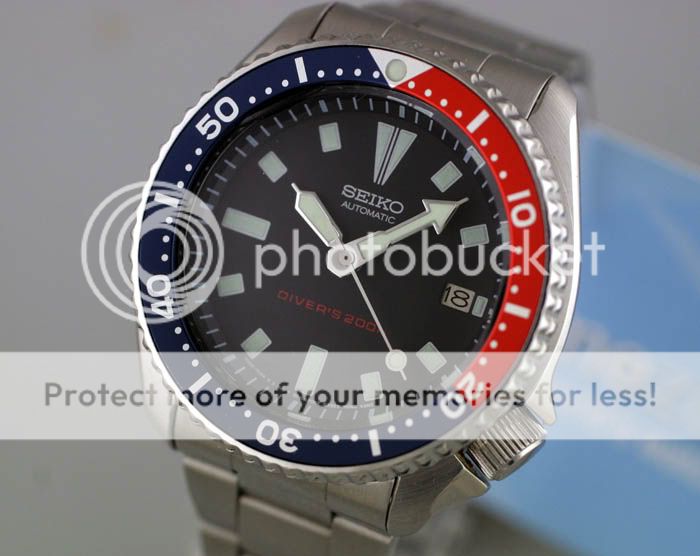
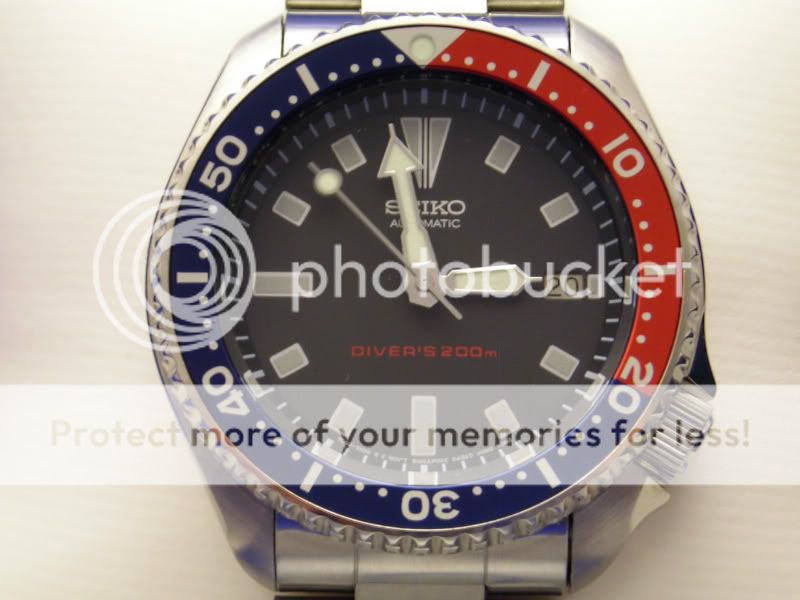
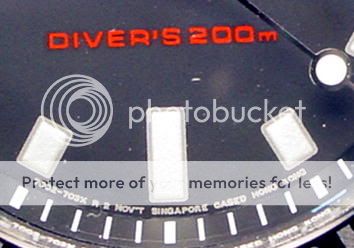
7002-7020 & 7002-7029: Essentially the same watch but with assigned different numbers in order to identify the market they were intended for. If the traditional Seiko numbering convention was used, the 7029 should be the North American, while the 7020 the international one. However, both models have been found in the US and other than the numbers differences have been observed.
This model is essentially the same as the 7039 second generation 7002 diver but with a different dial and a different bezel. Unlike prior normally aspired Seiko ISO divers, the 7020 introduced Seikos earliest attempts at introducing considerable styling changes to their intro-level diver line, which gave these 7002 a dressier appearance than their siblings. The bezel in the 7020 is an all-metal starfish shaped bezel (with recessed numbers instead of an insert) reminiscent of similar designs from Tag-Heuer. The dial is black and has round metal-framed applied markers on the minute markers and date window, reminiscent of those found in quartz Seiko divers and, to a lesser degree, the 6309 diver. The 6, 9 and 12 markers are also characterized by stylized curves instead of straight edges. 7020s used the same hands as earlier 7002s, but the second hand reversed the position of the flying meatball lume dot from the leading end of the second hand to the trailing end and extended the trailing end a few extra millimeters so that it resembles a trailing floating dot. The dial code on these normally reads: 7002- 702 R 2.
Black dialed version:
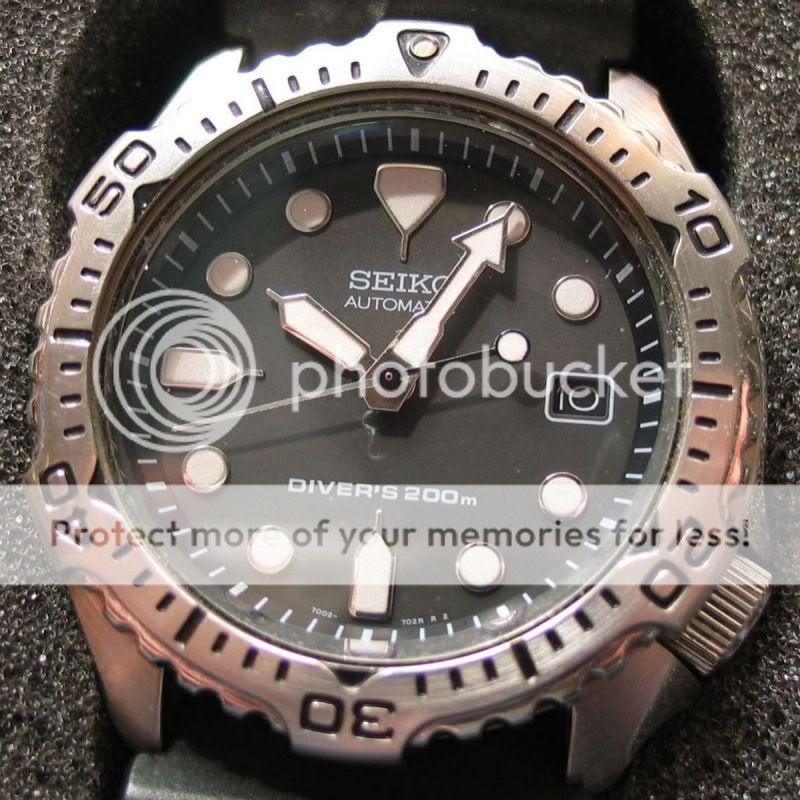
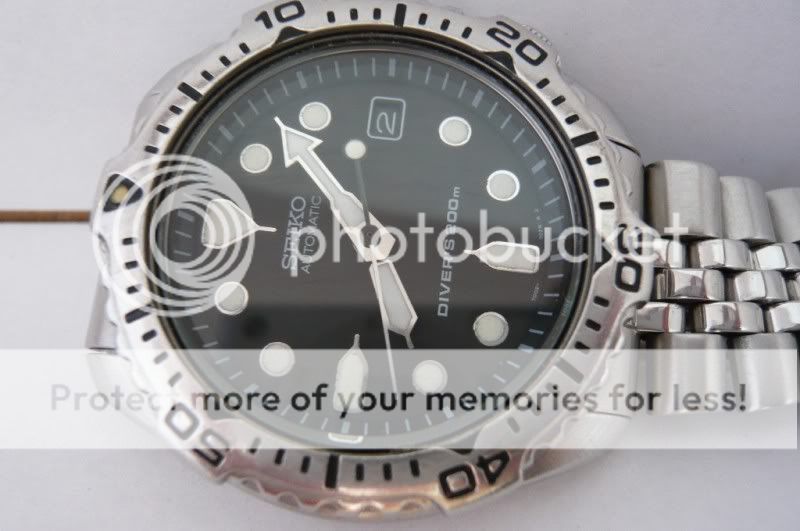
There is a much less common variant of the 7002-7020/7029 which identical in every respect to the variant discussed above, except that it has a dark blue dial and chapter ring, instead of the more common black dial and chapter ring. The blue dialed variant was not reissued when the watch was re-made as the SKX171, thus making it one of the rarer and more sought after 7002s.
Blue dialed version:
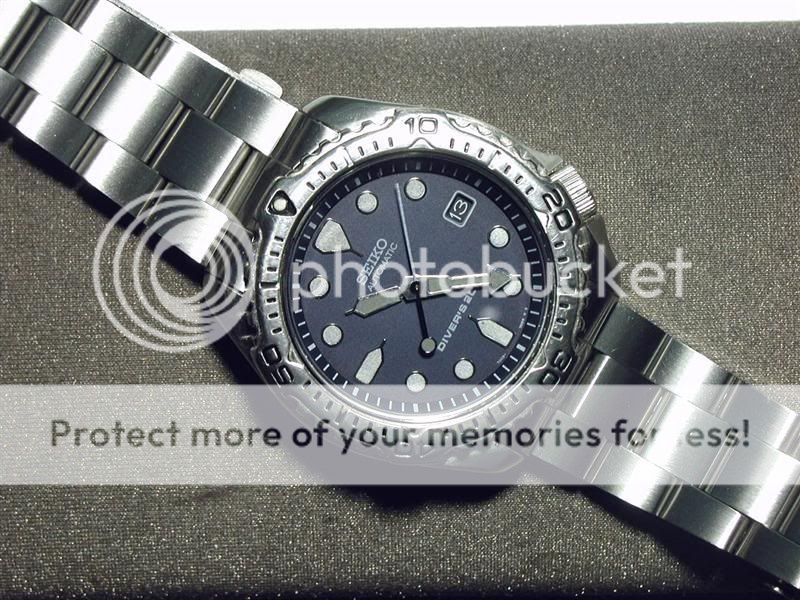

- please note that all the dial codes mentioned above were based on research for and contributions to this guide. If any of you have dial codes that differ from those listed above, please let me know so they can be included in the guide.
------------------------------------------------------------------------------------------
UPDATE - 4/28/09:
I received an interesting update from Jose Francisco from Brazil. It appears that during the 80´s and 90´s Seiko had a factory in Brazil, where they assembled a variety of models. At least one of those models seems to have been from the first generation of the 7002 line. Jose Fracisco has one such piece. a 7002-7000 from August 1995. It is interesting to note that the watch was a first generation model but was produced in this Brazilian factory well into the second generation's time. The way to tell any seiko's that came out of this factory is because the casebacks of watches produced there, in addition to the regular caseback markings are marked with the following text: Prod. Z.F
Here are a couple of pictures of Jose Francisco's 7002-7000 so you can see the caseback markings:
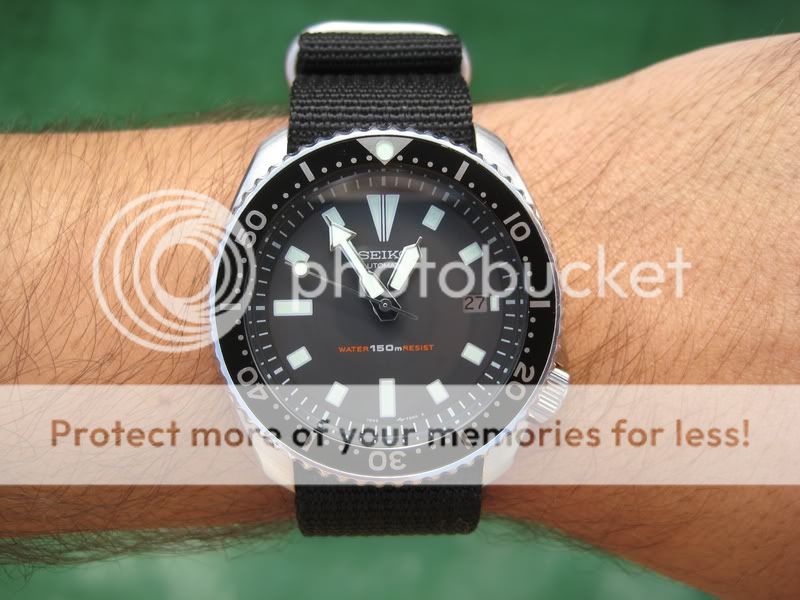
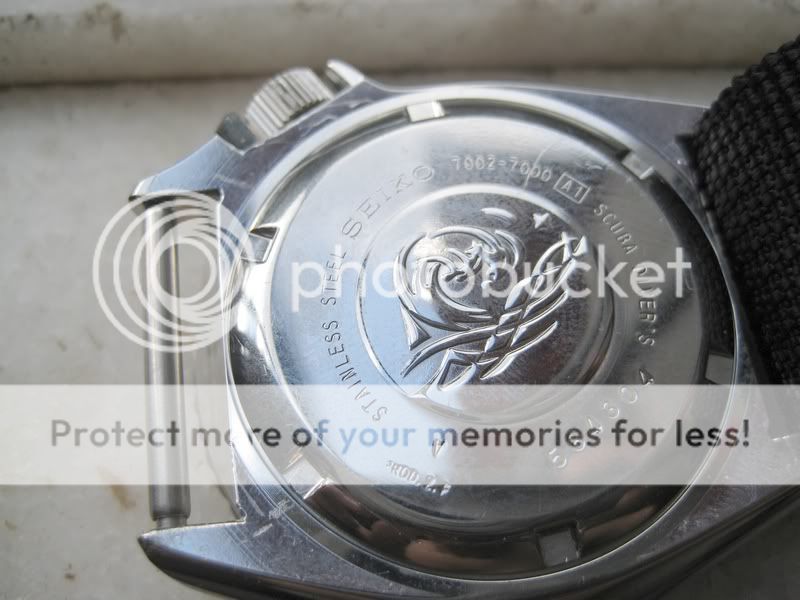
EBay listings often claim that these watches are rare. That is just not true. They are, however, in high demand from collectors in Europe and North America. This is especially true of examples in good condition.
When buying a 7002 do yourself a favor and spend the money to buy the best example you can find. Buying a mediocre one and paying for restoration can get more expensive than if you had done your homework to begin with. Try to keep your purchase price from eBay at no more than $100.00-$150.00 for a good clean example in good working order (keeping in mind the additional expense of servicing or overhaul that it will definitely need) it is not uncommon to find good examples in the $60-$80 range. For a perfect example, or a nicely restored example (from a well known restorer), expect to pay as much as $200-$250 depending on the level of restoration and the particular variant (Japan only 7001s tend to be more expensive) of the watch (that price should include the cost of the watch plus the cost of a full restoration with original parts, as well as an original strap, and a perfect bezel insert).
MAKE SURE TO ASK YOUR SELLER ALL OF THE QUESTIONS YOU HAVE AND DON'T BUY UNLESS HE ANSWERS TO YOUR SATISFACTION.
I've been looking into Seikos trying to figure out the models, movements and the interchangeability of the parts and found his posts to be very informative.
Thanks Gabe!
http://forums.watchuseek.com/showthread.php?t=258086
The following is a guide made from my own observations, together with research of many many posts made on SCWF and WUS regarding these watches over the past many years, and excellent direct feedback provided by several forum members. To all who have looked into these watches in the past, and to those who so graciously donated your time and effort to help make this guide a reality, you have my most sincere thanks. Most particularly special thanks to Richard Ng for his tireless editing and his generous image donations, as well as Mark Adeney, Lew Brown and Jack Alexyon, who at one time or another have all served as a second set of eyes and a never ending fountain of knowledge and advice. Also big thanks to Shawn Stanford, who's diver heaven articles were a wonderful resource and guide to follow in creating this guide. The pictures included have been donated by different members. However I also flagrantly "borrowed" some pictures that were posted to the forum and the divers reference (I hope you don't mind my using them here). There are so many pictures that I'm unable to keep track of them all, so if you see your picture being used and would like me to remove it or add your name as the source, please e-mail me and let me know. Also, if you have anything in the article should be quoted or attributed to you, also please let me know so I can make sure that it is. Once again, thanks to all those who donate of your time to review this guide and who donated images specifically for this project. Thanks all of you for your inputs.
Please note that the guide focuses solely on 7002 ISO rated dive watches and does not address other Seikos (including sport divers) that used the 7000 series of movements. Also please note that this is not a technical guide, but rather a general guide for enthusiasts and collectors to help them identify the different models of 7002 divers, their general history and condition.
I suspect there is information that has been left out so, please feel free to add any information and images you feel are worth adding. If anything you see in here is in need of expansion or correction, please let me know and I will gladly update it with any information you can provide.
I will only be making on-going updates to the copy of this guide saved on this Archive. If you ever need to find the most up to date version of this guide (as with the rest of the buying guides I've written) the one saved there will be the most current one.
THIS GUIDE MAY NOT BE REPRODUCED OR REPOSTED ANYWHERE ELSE WITHOUT MY EXPRESS PERMISSION. You are welcome to link to it where it is hosted on SCWF or Watchuseek.
I hope you enjoy the guide.
Gabe
------------------------------------------------------------------------------------------
HOW TO BUY A SEIKO 7002 DIVE WATCH

HISTORY:
The Seiko 7002 series of diving watches is the fourth generation of Seikos (normally aspired) professional/recreational ISO-rated automatic diving watches (this does not include Seikos deep diving shrouded divers or Seikos intro level ISO-rated quartz divers). The 7002 line of divers replaced the 6309 in 1988 and ran until 1996. It was replaced by the SKX line of divers in 1996. The 7002s use an entirely different movement from prior 6000 series based models used in earlier divers. The 7002s (especially the second generation) introduced many design changes to Seiko divers that are with us to this day.
The 7002 divers came in two generations spanning eight models. Both generations shared the same slimed-down case similar to the one introduced by the second generation 6309 divers, and a form of which is still in use to this day.
This guide will first focus on those things which all 7002 ISO rated divers share in common. The guide will then outline the eight separate models and the differences among them.
GENERAL CHARACTERISTICS:
7002 ISO rated dive watches are easily identifiable for having only a date wheel (no day). With the exception of the 7002-7020/9, they all use rectangular hour markers, which are covered in a greenish lume (possibly promethium) that predated Seikos use of lumibrite. This lume is notorious for aging poorly and for losing its luminous qualities after a few years, while still looking good cosmetically. This lume is also notorious for being copied by aftermarket parts sellers and being recreated to have lume with a neon-like green hue, which originals never had. The following is a description of the watchs specific characteristics:
CASE:
All 7002 divers come in a slimmed down stainless steel case similar to the one introduced by the second generation of 6309 divers. The case measures approximately 41mm in width (47mm including the crown); 45mm in length (lug to lug); 13mm in thickness; and 22mm in lug width. These cases also incorporate a small blister shaped guard which protects the crown and is somewhat reminiscent of the much larger guard found on vintage 6105 divers. It is important to note that since 7002 divers came in two generations there are two different but very similar cases used depending on which generation you have.
Overall, the case has a combination of polished surfaces (on the sides & bottom of the case and top of the crown guard) and machined/satin surfaces (on the top of the case and the lugs) and is composed of a combination of softly curved surfaces. The main creases on the case are found on either side of the case, where the bottom of the case curves upward and meets the downward slope of the upper part of the case. The creases along the sides of the case should be well defined (though not razor sharp), while those in the lower crown guard are slightly less sharp. Both tend to get rounded-off (the recess creases can sometimes disappear entirely) when cases are improperly refinished. Like the 6309-729A case that preceded it, the 7002 case does not have a beveled recess at either side of the crown. Instead, the inner parts of the crown guards are sharp vertical cuts that parallel the sides of the crown. The easiest way to tell the difference between a 7002 case and a slimmed down 6309 case is to look at the crown guards from the rear. You will notice that, because of the different crown designs, the 6309 case has an additional recess cut out into the base of the crown guards in order to fit the telescopic crown. The 7002 crown guards have a solid base with no cut-out.
The biggest differences between the two generations of 7002 cases are in the bezel mechanisms and in the crystals. If you remove the rotating ring, you will notice that the first generation 7002 is a solid surface underneath the bezel. The click mechanism is a spring loaded ball similar (but not exactly the same) to the one used in the 6309 divers series. In the second generation 7002 divers, when the bezel is removed, you will find a circular recess on the periphery of the crystal, inside you will find a circular click-spring, very much like those used on modern Seiko divers. Another difference is that the two generations use different sized crystals. First generation 7002s use a 32mm diameter crystal, while the second generation models use a 31mm diameter crystal.
These watches have integrated, threaded crown tubes which are intended to accommodate a traditional screw-down type crown and tube (previous 6309 Seiko divers used a thick telescopic type of crown system). It is important to note that damaged crown tubes cannot be replaced. Depending on the type and extent of the damage, a bad crown tube can destroy an otherwise great looking case.
Since so many of these watches were sold in and/or used in humid environments, it is very important to examine both the inside and outside of the case for signs of rust and, in particular, rust related pitting. Mild surface rust can be cleaned; pitting can be a sign of much more extensive damage and can ruin a case. Pay particular attention to corrosion to the inside of the case, under the gasket sealing areas of the case, to the flat surface where the gasket sits on the case-back, and to the threads where the case-back and crown screw in. Corrosion in these areas is common on these watches. A little bit of pitting on the threads can be halted, but too much can prevent the case-back from closing properly or can allow water to enter the watch when placed under increased water pressure. With new seals a case with slight rust damage to gasket sealing areas can be dust sealed, but probably not be made water-resistant. IF YOU WANT A WATER RESISTANT CASE GET ONE WITH NO RUST. Since the majority of you are desk divers, price is often an issue, and this is a vintage diver, you might be OK with a little bit of thread damage so long as the watch can be dust sealed - just avoid getting them wet, no matter how nice they look.
Lastly, deformation (and to a lesser degree rust) can also be an issue with regard to lug-pin holes. This part tends to have a greater potential for deformation and rust damage than most others. In order to correct deformation damage, unscrupulous repairmen tend to just drill the holes to a bigger size. The problem with this is that eventually the lug-pin holes get so large and worn out that it would be insane to expect a spring bar to stay in them. This is not fixable, and means the case is junk (unless you want to drill all the way through and manufacture your own screw type springbars I didnt think so). Try to use fat Seiko springbars whenever possible, as small ones will not fill in the lug pin holes fully and can scrape around the inside, deforming the hole.
CROWN:
Crown is a thick, horizontally toothed (for ease of finger-grip) unsigned crown, of a traditional spring loaded design mounted directly on the crown-stem as one piece (unlike the telescopic 6309 design). The crown should screw down a minimum of 1.5 complete turns (more is preferable). Any less than 1.5 turns and the threads are most likely damaged, and you would be wise to avoid this case. However, quite often crown turning problems tend to be caused by damaged crown threads (those on the inner/underside of the crown) and not the threads on the cases crown-tube. If you have a problem, you are advised to check before throwing out that case since the crown IS easily replaceable. It is important to note that the crown on the 7002 uses smaller gaskets than that of the preceding 6309, which makes the gaskets lifespan shorter. If you want to maintain water resistance, keep this in mind and have your gaskets changed accordingly.
BEZEL:
All first generation 7002 divers have mildly angled (the outer edge is marginally higher than the edge closest to the crystal) 60-click, bi-directional, non-locking bezels, with black-painted aluminum bezel inserts, silver markings and a large recessed round lume dot/pip.
Second generation 7002s (except 7002-7020 & 7029) have much flatter (the outer edge is closer in height to the edge closest to the crystal) 120-click, uni-directional (counterclockwise), locking bezels, with black-painted aluminum bezel inserts, silver markings and a small recessed round lume dot/pip.
The bezel in the 7002-7020 & 7029 is a 120-click, uni-directional (counterclockwise), locking bezel, with an all-metal starfish shape (with recessed numbers instead of an insert) reminiscent of similar designs from Tag-Heuer, and a medium recessed round lume dot/pip.
Bezel mechanisms on first generation cases use a spring-loaded click ball recessed into the top of the case at 1:30, and a bezel with 60 detent notches on its underside (similar in design to the system used in the 6309 divers):

[img]https://img.photobucket.com/albums/v373/Santeno/DIVERS/7002%20Gide%20Pictures/Bezel%20Mechanism/BezelMechanismMkI.jpg]/img]
Bezel mechanisms on second generation cases use a flat circular spring lying between the bezel and the case (similar to the system used in current SKX divers). The spring is prevented from rotating by two downward-facing tabs which engage two holes in top of the case. The spring engages the detent grooves of the bezel by two upward-facing tabs which engage the detent notches in the underside of the bezel. Interestingly, there are only 60 detent notches in the underside of the bezel, but a 120 click rotation is achieved by locating the upward-facing spring tabs so that one snaps in a notch as the other, located 177 degrees away, is midway between two notches:

The bezel inserts on 7002 divers vary slightly depending on the generation. First generation 7002 divers use the exact same bezel insert used in 6309 divers, right down to the oversized lume pip. Unlike 6309s, the first generation 7002s also had a Pepsi style variant of the same insert. Second generation versions used the insert used in the modern SKX divers, which is not angled and has a smaller lume dot. Bezel inserts in 7002s are removable and replaceable, so dont let a nice watch with a damaged insert keep you from getting a good deal. Keep in mind that both the bezel and the insert for each generation of 7002s, are different (inserts are interchangeable though). For instructions on how to change and remove a 7002 bezel and a bezel insert, check out this link (not about 7002s but the process is essentially the same):
http://www.network54.com/Forum/78440...6gt%3B%26gt%3B
The bezel ring itself is bordered by two stacked rows of rectangular cut protrusions that aid with finger-grip during bezel turning. If you look closely at the bottom of the bezel (where it meets the case), you will notice that ORIGINAL bezels are not flat, but rather have a series of tiny incisions/dimples which should be centered with the centerline that separates each rectangular finger grip aftermarket bezels sometimes lack these. If you buy a 7002 with a non-turning bezel, dont be disheartened; again, this should be a relatively simple fix and should not be a deal breaker.
It is worth noting that many owners have reported being able to swap entire bezel assemblies between 7002-7039s and 7Sxx/SKX divers as well as between the 7002-7020/9 and the SKX171. However these transplants are not always successful, with some reporting that the swapped parts sometimes fit too tight or too lose in the recipient watch. I have looked into the matter personally and found that although similar, second generation bezel assemblies are different and are not meant to be swapped with SKX divers, as they have ever so slightly different dimensions. First generation bezel assemblies are not swappable with any latter Seiko divers.
CRYSTAL:
The crystal should be a non-AR-coated Seiko Hardlex mineral crystal. It's supposed to be flat, have a frosted beveled edge, and should only protrude a minute amount beyond the top of the inner edge of the bezel but never beyond the outer edge of the bezel. Examples offered on eBay often have after-market crystals which noticeably project (stick out) above the bezel or use a domed acrylic crystal with curved edges. Proper aftermarket and Hardlex replacements do exist and can be sourced. After market sapphire crystals are popular and desirable modification for folks who intend to wear their watches on a daily basis (sapphire is great at scratch resistance), so dont dismiss a domed crystal as undesirable always ask the seller what type of crystal you are looking at. Be warned, however that most watchmakers will be unable to test the watch t its original stated depth rating after the crystal has been swapped.
The crystals on 7002 ISO divers are NOT held in place by a crystal retaining ring (as with the 6309). Instead they use a setup similar to what is used with todays SKX divers, where the crystal is pressed directly into a nylon crystal gasket avoiding the corrosion problems experienced by 6309 retaining rings.
CASE-BACK:
The case-back is a variation of Seikos standard 6-slot screw-type case-back. It is made of stainless steel and has a raised relief stamping of the full sized Seiko tsunami wave in the center. Deeply stamped (looking almost engraved) in a clockwise circular layout around the image of the tsunami wave can be found one of the following variants of the words:
1. JAPAN A (Daini lightning bolt logo) STAINLESS STEEL SEIKO (the word Seiko is written in larger font) 7002-70_ _ (with the being the case number for the corresponding model) A1 (inside a box) SCUBA DIVERS:

2. A (Daini lightning bolt logo) STAINLESS STEEL SEIKO (the word Seiko is written in larger font) 7002-70_ _ (with the being the case number for the corresponding model) A1 (inside a box) SCUBA DIVERS:

3. A (Daini lightning bolt logo) STAINLESS STEEL SEIKO (the word Seiko is written in larger font) 7002-70_ _ (with the being the case number for the corresponding model) A0 (inside a box) SCUBA DIVERS; or

4. A (Daini lightning bolt logo) STAINLESS STEEL SEIKO (the word Seiko is written in larger font) 7002-70_ _ (with the being the case number for the corresponding model) A0 (inside a box) SCUBA DIVERS. On this variant the text MOVT SINGAPORE can be found written left to right below the tsunami logo directly above the serial number.

I believe that the first two caseback codes (marked A1) belong to first generation cases and the second two (marked A0) belong to second generation cases. However Im not positive about this so feel free to verify this and correct me. If anyone notices other variants of the caseback information, please let e know and Ill include it in an update to this guide.
Below the image of the wave, deeply stamped (looking almost engraved) in a standard, straight (non-arched), left to right horizontal layout is the watchs specific, six-digit serial number.
Often times when case-backs are refinished, the stamped information gets sanded to the point of looking worn or faded. It is supposed to be sharply stamped, and it is never laser etched.
DIAL:
With the exception the 7002-7020 and 7002-7029, the faces of all 7002 divers are characterized by rectangular hour markers at 1, 2, 3, 4, 5, 6, 7, 8, 9, 10 & 11. The rectangular-shaped hour markers at 6 & 9 are about twice the length of those at 2, 4, 5, 7, 8, 10 & 11. The rectangular marker at 3 sits outboard of the date window and is a little less than half the size of those at 2, 4, 5, 7, 8, 10 & 11. The hour marker at 12 is composed of two identical downward pointing right scalene triangles, set mirroring each other and with the right angle at the top inner corner. There is a line of silver paint that separates each of the triangles.
With the exception of the 7002-7020 & 7002-7029, the date wheels on 7002 ISO divers are silver in color and have Arabic numerals written in black ink. 7002-7020 & 7002-7029 ISO divers use black date wheels with Arabic numerals written in white ink.
All hour markers are lumed. However, it must be noted that the lume is relatively flat and does not occupy the entire hour marker (it is framed by the markers silver border). Original factory lume, as seen in the picture below, has an almost textile looking quality to it, almost like it is linen, with slight cross hatching visible when viewed with a strong loupe (this is from the printing process Seiko used). It is important to note that the lume used in 7002s was different than that used in preceding 6309s, as well as that used in subsequent SKX divers.
7002 lume has a greenish silvery color to it when seen under visible light and glows with a noticeable bright greenish hue. When new, 7002 lume tended to be rather bright green, however, as it aged, it tended to quickly turn grey when exposed to environmental moisture. Sadly 7002 lume was not of the same quality as the lumibrite in use today. The greenish lume had a tendency to lose a considerable amount of its luminosity after a few years. During the 1980s Seiko switched to a radioactive compound made of Promethium-147 as the basis for the lume used in 7002 divers. The luminous properties turned out to have a pretty short life span and didn't last nearly as long as the old tritium-based lume Seiko used in the 1970's. This is why a lot of the 7002 divers seem to have lume problems even though they are a relatively new watch, and today are "outshined" by original lume on 6309 divers which are nearly twice their age. Most 7002s found today, when they have clean dials, tend to have lume with little to no luminosity left. It is worth noting that some collectors believe that Seiko might have experimented with different lume applications or types of lume during the production life of the 7002 line. I have not been able to find definitive proof of this, but I believe that there might be at least two different forums of lume used by Seiko on this model. Also, the 7020 variant definitely uses a different form of lume that is completely white.
Here is a link with lots of interesting technical information on Promethium-147:
http://www.hps.org/publicinformation/ate/q3408.html
and here is a slightly less technical post explaining the differences between Promethium, Lumibrite and Tritium, as used by Seiko (read to the end):
http://www.larrybiggs.net/scwf/index...&id=1085718911
All 7002 first generation ISO-rated Divers have the words SEIKO AUTOMATIC written in whitish silver paint one above the other, directly below the 12:00 marker and the words WATER150mRESIST just above the 6:00 marker. More specific dial details will be addressed when we talk about the specific 7002 models.
It is worth noting that, in original condition, the words WATER and RESIST were painted in an orangey shade of red, while the 150m was painted whitish silver paint. However, over the years the red color tends to fade, turning anywhere from orange to yellow to grey over time (so dont stress too much about finding them in perfect red condition). Having this text in white is a dead giveaway of an aftermarket dial. The only white on the 7002 dial should be the dial code:

Below the 6:00 marker, stretching as far as between the 7:30 & 4:30 is written in tiny white letters the dial code. These dial codes tell us what movement the dial belongs to, what dial version this is, and sometimes where the dial was made, where the case was made and what market the watch was originally destined for, be it Japan, the Americas, or everybody else.
It is important to note that, unlike with 6309s, it is considerably more difficult to tell a reproduction dial from a real one by analyzing the dial code. The easiest way to determine the authenticity of a 7002 dial is by paying close attention to the color of the lume (which should never have a bright green or neon-like hue to them, and which should always be framed in their markers in silver paint, not white). Because of the sheer variety of dials and dial codes (and inconsistency in lume degradation) it is not as easy to tell a fake 7002 dial from an original, as it is with 6309's. A good rule of thumb is that the lume in 7002's does not age well and tended to darken rather quickly from its bright green original condition. It is very uncomon to find these bright green lumed dials. Many of the current reproductions have this bright green lume on watches that have obviously seen better days. Text size on dial codes is also a way to tell a reproduction from an original.
In the case of second generation 7002 divers, the description above applies to the dials of 7002-7039s with the exception that, instead of saying WATER150mRESIST, the watchs rating upgrade cased the text to be changed to DIVERS 200m, written in red (a slightly darker shade than the orangey red used in the first generation):

7002-7020s and 7002-7029s have drastically different dials. Unlike all other 7002s and 6309s which had printed dials, these models had polished silver, applied hour markers. The faces of all 7002-7020 and 7002-7029 divers are characterized by circular applied hour markers at 1, 2, 4, 5, 7, 8, 10 & 11. The hour markers at 6 & 9 are pentagon shaped with a projecting tip and resemble the silhouette of a house. They are very similar to the general shape of the hour hand but with parallel sides instead of tapered ones. There is no hour marker at 3, but the date window is framed by a silver painted box with rounded corners just outboard of the actual date window cut-out. The hour marker at 12 is similar to the shape of the markers at 6 and 9, but is about twice as wide and with the proportions reversed (the outer section is shorter while the inner section is longer and has a longer tip). Like the hands, the hour marker lume filled the entire space within the polished frame of the marker. Unlike prior 7002s, the lume used in these models was not green but rather white. Like the 7039, the 7002-7020 and 7002-7029 divers also replace the WATER150mRESIST rating text from the first generation 7002s to DIVERS 200m. Unlike the 7039, the 7002-7020 and 7002-7029 divers had DIVERS 200m written in the same whitish silver paint used in the words SEIKO AUTOMATIC, instead of red.:

All 7002s used the same black chapter ring with 60 white minute markers. The minute markers where slightly thicker at every 5 minute mark than at the minute markers in between.
HANDS:
Unlike flat 6309 hands, original 7002 hour hands are flat-topped and have rounded edges and finished in a high polish. Replacement hands from Seiko will be identical to those used in modern SKX divers. All the watchs hands are polished metallic hands and are silver in color. The hour and minute hands have a large lume insert in the middle that follows the shape of the hand. Unlike the hour markers, the lume on the hands fills the entire space of the insert. With the exception of the 7002-7020 & 7002-7029, the second hands are very similar to those used in the prior 6309s, except that they have slightly rounded outer edges. 7002 second hands only have a lume dot near their outer end, which like the lume used on the hour markers is not puffy.
7002-7020s & 7002-7029s used the same hour hands as earlier 7002s, but the second hand reversed the position of the flying meatball lume dot from just below the leading end of the second hand to the trailing end and extended the trailing end a few extra millimeters so that it resembles a tail. In addition the second hands on 7002-7020s & 7002-7029s are painted in a glossy black paint from the central axle hub to the lumed meatball the forward, un-lumed, pointy end is left unpainted, in what Seiko calls a Day/Night configuration.
MOVEMENT:

7002s use a form of Seikos workhorse 17 jewel 7000 series automatic caliber. The movement cannot be manually wound, is non-hacking and has crown operated quickset day/date calendar mechanisms. The movement is loosely based on seikos 7000 series of movements from the early 70s, such as the 7005. Unlike its ancestors or the 6309 that preceded it, the 7002 has fewer parts, uses stamped metal parts instead of machined metal parts (modern 7s movements are also stamped), uses plastic parts much more extensively than prior Seiko movements, and has a slightly shorter power reserve than the 6309 (still 40+ and in keeping with the similar power reserve of the 7s movements that followed). Many on the boards have commented that the reason for these design and construction changes where largely due to Seiko looking to create a less expensive movement, because of the pressures of the quartz revolution placed on the mechanical movement market.
7002s also use a plastic movement spacer ring, whereas the 6309 used a metal ring with a compression spring on it. Over time, the plastic Spacer ring can become susceptible to temperature fluctuations and contract or deform, causing a not-quite perfect fit, which has been known to allow minor dial movement when adjusting the time (this is correctible by simply replacing the old spacer with a new one).
It is important to note that as a result of cost savings sought in the design and construction of the 7002 movement, while 7002 movements remain robust and solid movements, overall they just dont tend to age as well as their older 6309 counterparts. In part this is reflected in current resale values for 7002s (very good examples of which can still be had for under $100), which do not approach those of the similar 6309-7290 (let alone the 7040/9). Again, none of this means that the 7002 is a bad movement. It only means that compared to its predecessors, more emphasis was place in cost control than in overall movement construction and longevity. The 7002 series of movements are good movements, but when compared to their predecessors (and their successors) perhaps not great.
For the common buyer, so long as the movement works and keeps good time, make sure that the movement looks clean with no black, pitted or rusted parts, and make sure that you have an un-cracked plastic movement spacer ring.
As an aside, the modern 7S series of movements are direct evolutions of the 7002 movement. Seiko did correct some of their less desirable design approaches in the 7002 in the design of the subsequent 7s26, while still retaining their focus on robustness and economy. In the 7Sxx series of movements Seiko made the power reserve a little longer by increasing the number of cap jewels (7s26= 21J vs. 7002=17J). They also made changes to the balance assembly resulting in better accuracy. The 7002, along with corrections and modifications, evolved into the 7Sxx series of movements we know today (and the 6rxx series is a further evolution of that). However, in many ways neither of these later movements truly compare to the 6309 in terms of finish or construction. If you want to learn more about their differences between the 7000 series and the 6309, read the last 2 posts on this thread:
http://www.larrybiggs.net/scwf/index...1&id=997293604
In addition here is a wonderful and rather technical site outlining the general differences between the 7000 series of movements and the 6000 series of movements:
http://adenoma.sites.uol.com.br/61xx-70xx-english.html
If you want to learn more about the differences and similarities between the 7000 series and the 7s movements that followed, please read these 2 posts by Adriano:
http://www.network54.com/Forum/78440...o+they+differ-
http://www.network54.com/Forum/78440...hat%2C+in+fact
STRAP:

First generation 7002s were only offered with black, straight vented GL-831 rubber straps. The long strap has two vents separated by flat ridges and 11 adjustment holes followed by an image of the Seiko tsunami wave inside a recessed circle near the rounded tip. The short strap has 3 vents separated by flat ridges, 3 offset rows of non-usable perforations and an unattached rectangular strap-guard with 5 similar perforations. The end is followed by a smallish (for the watch) traditional buckle set-up with the words SEIKO.ST.STEEL.JAPAN.Z on the underside.

Some people strive for originality and must have an original strap. The original strap should be marked "SEIKO GL-831 JAPAN". Seiko made them of a silicone rubber compound. Today, the market is flooded with replacement rubber straps from all kinds of sources. I would not suggest stressing over the correct rubber strap and would advice that you find a good after market replacement.

Second generation 7002 divers also used GL-831 rubber straps, however they also introduced the use of metal oyster style (and jubilee) bracelets. I have not been able to confirm whether the jubilees used in the 7002 had solid outer links or folded ones. If any of you have an original and could confirm, Ill include the information in an update to this guide.
Its worth noting that Seiko divers use FAT spring-bars. These are not regular 22mm spring-bars, but rather heavy duty 22mm spring-bars made especially for Seiko divers.
SPECIFIC MODEL DIFFERENCES:
The 7002 divers came in two generations, both in a slimmed down case similar to the one introduced by the second generation 6309 divers and in a form of which is still in use to this day. Unlike the 6309 that preceded it and the SKX that followed it, there are no orange or yellow dialed 7002 ISO-rated divers!!! It is worth noting that as with the 6309's that preceeded it there was some overlap in the production run between the first and second generations. At least in some markets, where seiko produced watches locally, such as brazil (see update below), the first generation continued in production right to the end of the entire model line's (firs and second generation) production run.
The eight different models and two generations of the 7002 diver are as follows:
FIRST GENERATION
7002-7000: This is the international version (non-Japan / non-U.S.) of the normally aspired 150m-rated 7002 (1st generation) diver. Except for the caseback marketing code, it is identical to the 7002-7009 diver (0 instead of 9). It is ISO rated to 150m. The dial code on these normally reads either as: 7002-700X R ~ MOV'T SINGAPORE DIAL JAPAN CASED HONG KONG; or can also read as: 7002 (Daini lightning bolt logo) 700R R

7002-7009: This is the U.S. version of the normally aspired 150m-rated 7002 (1st generation) diver. Except for the caseback marketing code, it is identical to the 7002-7009 diver (9 instead of 0). These 2 are both 150m divers. It is ISO rated to 150m. The dial code on these normally reads: 7002-700X R (Daini lightning bolt logo) MOV'T SINGAPORE DIAL JAPAN CASED HONG KONG.


7002-7001: This is the Japanese home market version of the normally aspired 150m-rated 7002 (1st generation) diver. It is supposed to be cased in Japan and have a Japan made movement. It differs from the more popular 7000 and 7009 in that the jewel-count (17 Jewels) is written on the dial directly below the depth rating (WATER150mRESIST). The dial code on these normally reads: MADE IN JAPAN 7002-700L R , followed by the Daini lightning bolt logo.


7002-700A: This is the international version (non-Japan / non-U.S.) of the normally aspired 150m-rated 7002 (1st generation) Pepsi diver. It is largely identical to the watches above except that it has a blue-and-red Pepsi-style bezel. The dial code on these normally reads: 7002 (Daini lightning bolt logo) 700R R.


7002-700J: This is the Japanese home market version of the normally aspired 150m-rated 7002 (1st generation) Pepsi diver (according to Shawn Taylor). Like the 7002-7001 it differs from the more popular 7000A in that the jewel-count (17 Jewels) is written on the dial directly below the depth rating (WATER150mRESIST). Like the 700A, it also has a blue-and-red Pepsi-style bezel. As with the 7002-7001, the dial code on these normally reads: MADE IN JAPAN 7002-700L R , followed by the Daini lightning bolt logo.



SECOND GENERATION
7002-7039: This is the international version (all markets) of the normally aspired 200m-rated 7002 (2nd generation) diver. This model is the first normally aspired ISO rated Seiko diver to have its water resistance rating upgraded to 200m. It is believed that Seiko increased the depth ratings on their base divers in response to revised ISO standards. The watch came available with both black and Pepsi-style bezels (aside from the bezel insert color, they were otherwise identical). While the first generation (150m) 7002 divers had 60-click bi-directional bezels, second generation (200m) 7002 divers came with a uni-directional (counterclockwise turning) 120-click locking bezel. It is worth noting that not only is the bezel assembly different from that of earlier 7002s, but the insert is also a different part number from that of earlier 7002s (which were shared with the 6309 divers that preceded them). These divers also mark the first time the depth rating dial text changed from WATER150Mresist to DIVER'S 200m, as used in modern SKX divers. The dial code on these normally reads either as: 7002-703X R 2 CASED HONG KONG; or as 7002-703X R 2 MOV'T SINGAPORE CASED HONG KONG.




7002-7020 & 7002-7029: Essentially the same watch but with assigned different numbers in order to identify the market they were intended for. If the traditional Seiko numbering convention was used, the 7029 should be the North American, while the 7020 the international one. However, both models have been found in the US and other than the numbers differences have been observed.
This model is essentially the same as the 7039 second generation 7002 diver but with a different dial and a different bezel. Unlike prior normally aspired Seiko ISO divers, the 7020 introduced Seikos earliest attempts at introducing considerable styling changes to their intro-level diver line, which gave these 7002 a dressier appearance than their siblings. The bezel in the 7020 is an all-metal starfish shaped bezel (with recessed numbers instead of an insert) reminiscent of similar designs from Tag-Heuer. The dial is black and has round metal-framed applied markers on the minute markers and date window, reminiscent of those found in quartz Seiko divers and, to a lesser degree, the 6309 diver. The 6, 9 and 12 markers are also characterized by stylized curves instead of straight edges. 7020s used the same hands as earlier 7002s, but the second hand reversed the position of the flying meatball lume dot from the leading end of the second hand to the trailing end and extended the trailing end a few extra millimeters so that it resembles a trailing floating dot. The dial code on these normally reads: 7002- 702 R 2.
Black dialed version:


There is a much less common variant of the 7002-7020/7029 which identical in every respect to the variant discussed above, except that it has a dark blue dial and chapter ring, instead of the more common black dial and chapter ring. The blue dialed variant was not reissued when the watch was re-made as the SKX171, thus making it one of the rarer and more sought after 7002s.
Blue dialed version:


- please note that all the dial codes mentioned above were based on research for and contributions to this guide. If any of you have dial codes that differ from those listed above, please let me know so they can be included in the guide.
------------------------------------------------------------------------------------------
UPDATE - 4/28/09:
I received an interesting update from Jose Francisco from Brazil. It appears that during the 80´s and 90´s Seiko had a factory in Brazil, where they assembled a variety of models. At least one of those models seems to have been from the first generation of the 7002 line. Jose Fracisco has one such piece. a 7002-7000 from August 1995. It is interesting to note that the watch was a first generation model but was produced in this Brazilian factory well into the second generation's time. The way to tell any seiko's that came out of this factory is because the casebacks of watches produced there, in addition to the regular caseback markings are marked with the following text: Prod. Z.F
Here are a couple of pictures of Jose Francisco's 7002-7000 so you can see the caseback markings:


EBay listings often claim that these watches are rare. That is just not true. They are, however, in high demand from collectors in Europe and North America. This is especially true of examples in good condition.
When buying a 7002 do yourself a favor and spend the money to buy the best example you can find. Buying a mediocre one and paying for restoration can get more expensive than if you had done your homework to begin with. Try to keep your purchase price from eBay at no more than $100.00-$150.00 for a good clean example in good working order (keeping in mind the additional expense of servicing or overhaul that it will definitely need) it is not uncommon to find good examples in the $60-$80 range. For a perfect example, or a nicely restored example (from a well known restorer), expect to pay as much as $200-$250 depending on the level of restoration and the particular variant (Japan only 7001s tend to be more expensive) of the watch (that price should include the cost of the watch plus the cost of a full restoration with original parts, as well as an original strap, and a perfect bezel insert).
MAKE SURE TO ASK YOUR SELLER ALL OF THE QUESTIONS YOU HAVE AND DON'T BUY UNLESS HE ANSWERS TO YOUR SATISFACTION.

andrema- Man About Town
- Posts : 1074
Join date : 2010-08-02
Age : 114
 Similar topics
Similar topics» HOW TO BUY A SEIKO 6309 DIVER
» Cool Site - Another resource for Seiko Parts and all things Seiko
» Cool Site - Another resource for Seiko Parts and all things Seiko
» Seiko Sumo v. Seiko Marinemaster
» Lum-tec 300m Diver
» Cool Site - Another resource for Seiko Parts and all things Seiko
» Cool Site - Another resource for Seiko Parts and all things Seiko
» Seiko Sumo v. Seiko Marinemaster
» Lum-tec 300m Diver
Page 1 of 1
Permissions in this forum:
You cannot reply to topics in this forum
